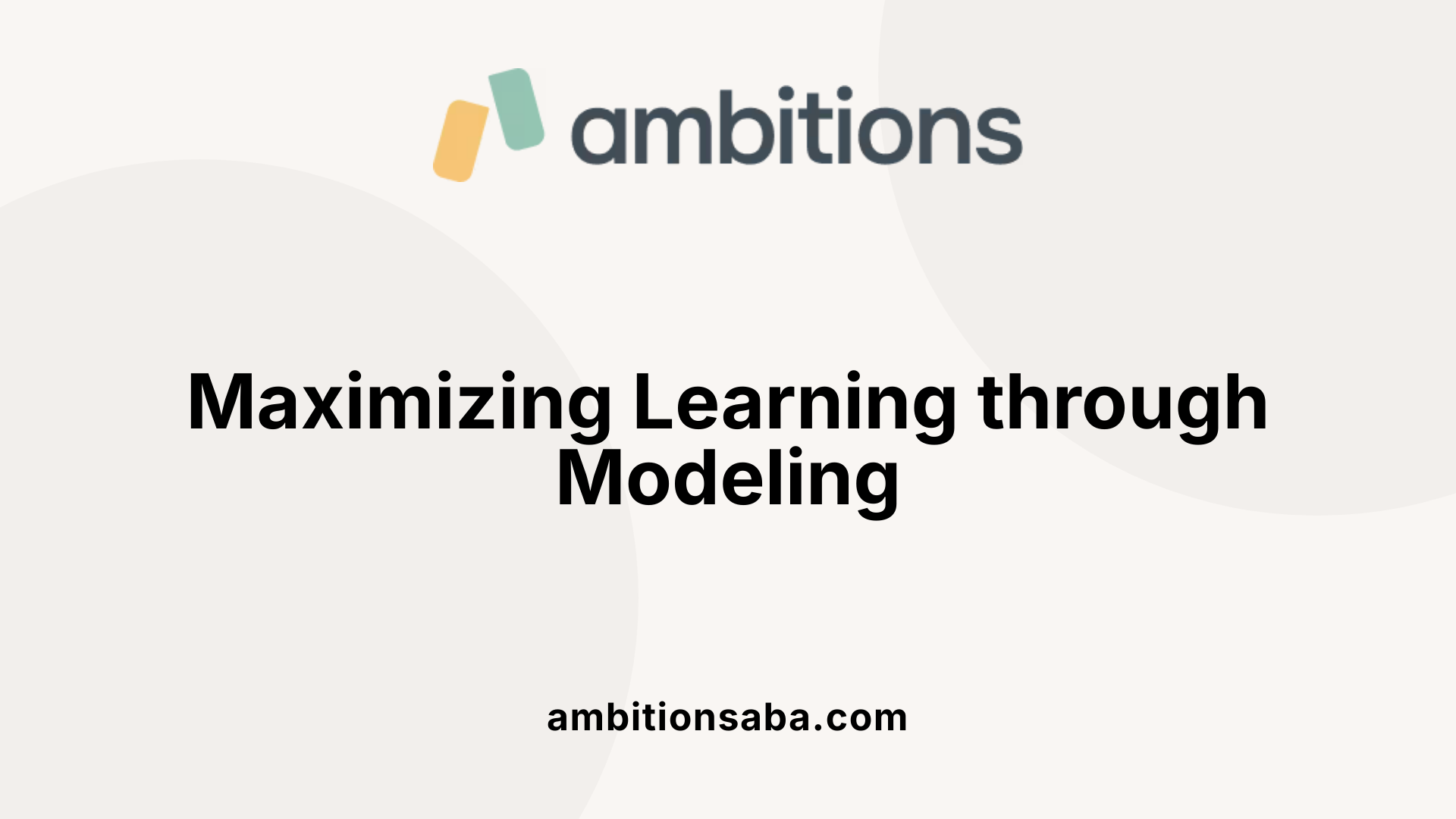Exploring Response Cost: A Key Behavioral Strategy in Therapy
Understanding ABA and the Power of Modeling
Applied Behavior Analysis (ABA) therapy is a scientifically validated approach widely used to support individuals on the autism spectrum. Central to many ABA interventions is the technique of modeling, where learners observe and imitate behaviors to acquire new skills. This article explores the critical role modeling plays within ABA, its various forms, implementation strategies, benefits, and considerations for maximizing its effectiveness in autism therapy.
What is Applied Behavior Analysis (ABA) Therapy?

Definition and Scientific Basis of ABA Therapy
Applied Behavior Analysis (ABA) therapy is a science-based approach grounded in behaviorism. It focuses on understanding how behavior works and is influenced by the environment, and systematically uses this knowledge to teach new skills and reduce harmful or non-learning behaviors.
Key Principles such as the ABC Model and Positive Reinforcement
ABA relies heavily on the ABC model, which examines Antecedents that trigger behaviors, the Behavior itself, and the Consequences that follow. Positive reinforcement – rewarding desired behaviors – encourages repetition and skill acquisition, making it one of the foundational techniques in ABA.
Individualized Program Design and the Role of BCBAs
Each ABA program is precisely tailored for the individual based on a comprehensive assessment conducted by a qualified Board Certified Behavior Analyst (BCBA). The BCBA sets specific, measurable goals and chooses techniques that best suit the person's unique learning style and needs.
Goals of ABA Including Communication, Social Skills, and Daily Living
ABA therapy targets improvements across vital skill domains including communication, social interactions, self-care, play, motor skills, and academic abilities. It aims to build independence and overall quality of life by helping individuals gain practical skills that generalize across settings such as home, school, and community.
How ABA Therapy Supports Individuals with Autism

Teaching New Skills and Reducing Challenging Behaviors
ABA therapy supports individuals with autism by focusing on teaching new skills and managing challenging behaviors. Using well-founded behavioral techniques, complex skills are divided into smaller, achievable steps. Modeling, for example, offers clear, observable demonstrations for the learner to imitate, enhancing understanding and skill acquisition. Strategies like prompting and behavior chaining further scaffold learning, making seemingly difficult tasks accessible.
Use of Positive Reinforcement and Behavioral Techniques
Positive reinforcement is central to ABA, where desired behaviors are encouraged by rewarding them. This approach increases the likelihood that good behaviors will be repeated. Techniques such as redirection and extinction help reduce harmful or unhelpful behaviors by altering the environment and consequences. The combination of reinforcement with structured teaching methods promotes sustainable behavioral improvements.
Personalized Program Development and Goals
Each ABA program is uniquely tailored to the individual's needs. Qualified behavior analysts (BCBAs) conduct comprehensive assessments to identify strengths and areas for growth. Based on these, they develop measurable goals in communication, social skills, self-care, play, and academics. The therapy adapts to different settings—home, school, or community—and formats, whether one-on-one or group, ensuring relevance and effectiveness.
Fostering Independence and Improved Quality of Life
Through consistent skill-building and behavior management, ABA fosters greater independence in individuals with autism. Enhanced communication, social competence, and self-help abilities contribute to better engagement in daily life. Improved confidence and self-esteem arise from mastering new tasks, helping individuals navigate diverse environments. Ultimately, ABA aims to elevate quality of life by reducing barriers and supporting functional, meaningful participation in society.
Who Provides ABA Therapy and Their Qualifications

Role of Board Certified Behavior Analysts (BCBAs)
ABA therapy is primarily delivered by Board Certified Behavior Analysts (BCBAs). These professionals are specially trained to design and oversee ABA interventions. They hold graduate-level degrees in fields like applied behavior analysis, psychology, or education. BCBAs develop individualized treatment plans, set measurable goals, and ensure that therapy aligns with best practices.
Educational and Training Requirements
To become a BCBA, individuals typically must complete a master's degree focused on behavior analysis or a related area. This is complemented by extensive supervised clinical practice, often ranging between 1,500 and 2,000 hours. After fulfilling these requirements, candidates must pass a rigorous certification exam administered by the Behavior Analyst Certification Board (BACB).
Supervised Clinical Practice and Certification
Supervised fieldwork is a critical component of BCBA credentialing. It allows aspiring analysts to apply learned principles in real-world settings under the guidance of experienced practitioners. Once certified, BCBAs must engage in continuing education to maintain their credentials, staying current with evolving research and techniques.
Other Professionals Involved in ABA Delivery and Their Qualifications
Besides BCBAs, ABA therapy involves registered behavior technicians (RBTs) and other trained therapists who implement treatment plans. These individuals usually possess at least a bachelor's degree and have received specialized training or certification in ABA techniques. Their work is supervised by BCBAs who ensure interventions are conducted effectively and ethically.
ABA therapy teams employ evidence-based strategies such as positive reinforcement and discrete trial training to support individuals with autism spectrum disorder (ASD) in acquiring new skills and improving behaviors. The combination of formal education, supervised practice, and certification ensures that therapy is delivered by well-qualified professionals committed to fostering meaningful development.
The Role of Modeling in ABA: Concept and Types

What is modeling and how does it function in ABA?
Modeling in Applied Behavior Analysis (ABA) is a fundamental teaching strategy where individuals learn new skills by watching and imitating others. This technique provides clear behavioral examples, allowing learners—especially those with autism spectrum disorder (ASD)—to better understand and replicate desired actions. By arranging specific situations for observation, modeling facilitates skill acquisition and behavior change effectively.
What types of modeling are used in ABA?
ABA employs a variety of modeling methods tailored to the learner's needs. These include:
- Physical (In-vivo) modeling: A live demonstration by a person performing the target behavior.
- Verbal modeling: Using words or scripts to show how a behavior is performed.
- Visual modeling: Showing videos or pictures illustrating the behavior.
- Peer modeling: Encouraging imitation of a peer exhibiting the behavior.
- Self-modeling: The learner observes recordings of their own successful behaviors.
- Audio modeling: Using sound recordings to demonstrate verbal behaviors or cues.
Among these, video modeling is notable for potentially faster skill acquisition compared to live demonstrations.
How are modeling methods tailored to individual needs?
Modeling approaches are selected based on the learner’s imitation ability, learning style, and specific goals. For example, individuals with strong visual processing benefit greatly from video or visual modeling, while others may respond better to live or verbal modeling. Moreover, therapists integrate prompting, reinforcement, and scripting to complement modeling, ensuring personalized and effective interventions. This flexibility helps maximize engagement, attention, and eventual generalization of skills across different environments.
Implementing Modeling in ABA Interventions

Systematic steps for effective modeling
Implementing modeling in ABA therapy involves a structured approach that guides learners through new skills. The process begins by identifying a target behavior that the individual needs to learn. Next, a clear and precise demonstration of the behavior is provided, which can be live (in-vivo), via video, or even through audio models designed to fit the learning context.
Arranging teaching situations for imitation
A critical component of modeling is arranging teaching situations where the learner can observe and imitate the modeled behavior effectively. This setup ensures the learner's attention is focused on the demonstration and that the environment supports successful imitation. Models may be peers, therapists, or videos showing specific skills such as greeting others or performing daily routines.
Use of scripting alongside modeling
Scripting often complements modeling in ABA by providing verbal or written cues to support the modeled actions. Scripts help individuals practice social and communication skills by offering structured language they can mimic. For instance, demonstrating how to share toys while using a scripted dialogue teaches both the action and the verbal interaction involved.
Incorporating prompting, feedback, and practice across settings
To enhance learning, therapists incorporate prompting to encourage imitation if the learner is hesitant. Positive reinforcement is provided as feedback to motivate repeating the behavior. Practicing these skills in various settings—from home to school—helps generalize the learned behavior across different environments, increasing independence and confidence.
By following these systematic steps and combining modeling with scripting and reinforcement, ABA therapists effectively facilitate behavior change and skill acquisition tailored to individual needs.
Benefits and Outcomes of Modeling in ABA Therapy

How Does Modeling Facilitate Learning and Skill Acquisition?
Modeling in ABA therapy involves demonstrating a behavior for individuals to observe and imitate. This clear example helps make learning new skills more accessible, especially for those with autism. Techniques such as physical, verbal, and visual modeling tailor the approach to different learning styles. Reinforcement through positive feedback encourages repeated practice, strengthening skill mastery.
In What Ways Does Modeling Support Social and Communication Skill Development?
Modeling is particularly effective in teaching social behaviors and communication skills. By observing models—whether a live person, video, or audio recording—learners grasp how to interact appropriately in various social settings. This method fosters improvements in greetings, sharing, and conversations, promoting meaningful social engagement.
How Does Modeling Encourage Generalization of Skills and Promote Independence?
One major advantage of modeling is encouraging skills to generalize across multiple environments, such as home, school, and community. Learning through observation and practice helps individuals apply behaviors to different contexts, reinforcing independence. Systematic implementation of modeling steps supports sustained behavior change and broader application.
What Role Does Modeling Play in Building Confidence and Self-Esteem?
Successful skill acquisition by observing and imitating others can boost learner confidence and foster a sense of achievement. As individuals master new behaviors through modeling, they gain greater self-esteem and motivation. This empowerment supports ongoing progress and independence in daily activities.
Research Evidence Supporting Modeling in ABA

What do studies say about the effectiveness of video versus in-vivo modeling?
Research comparing video modeling to in-vivo (live demonstration) modeling shows promising results for both methods in teaching skills to individuals with autism. Notably, studies like Charlop-Christy et al. (2000) found that video modeling can lead to faster skill acquisition than in-vivo modeling. This advantage is largely because video models can be paused, replayed, and accessed repeatedly, making them a flexible teaching tool.
Who benefits most from modeling techniques in ABA?
Modeling is particularly effective for individuals with autism who already have well-developed imitation skills. These individuals respond well to observational learning approaches, which help them acquire social, communication, and daily living skills by replicating demonstrated behaviors.
What gaps remain regarding the long-term effects and generalization of modeling skills?
While short-term gains from modeling techniques in ABA are well documented, more research is needed to understand long-term maintenance of acquired skills. Additionally, further studies should investigate how well these skills transfer across different environments and situations to ensure generalization beyond initial teaching contexts.
Which researchers provide influential insights on modeling in ABA?
Several peer-reviewed reviews and studies have shaped current understanding of modeling efficacy in autism intervention. For instance, Corbett and Abdullah (2005) provide a comprehensive review explaining why video modeling works well for children with autism. Charlop-Christy et al. (2000) offer direct comparisons between video and in-vivo modeling effectiveness, reinforcing the evidence base supporting video techniques.
Challenges and Considerations in Using Modeling Within ABA

Maintaining Attention and Motivation
One significant challenge in using modeling within ABA therapy is keeping the learner's attention and motivation high. Since modeling requires observation and imitation, children with autism may struggle to stay engaged during demonstrations, especially if the behavior being modeled is complex or not immediately rewarding. Therapists often need to incorporate reinforcements and tailor models to the individual’s interests to sustain motivation.
Consistency Across Environments and Caregivers
Ensuring consistency in modeling implementation across different settings and caregivers is essential but challenging. Skills learned through modeling must generalize from therapy sessions to home, school, and community environments for meaningful behavior change. Variations in how caregivers or teachers perform or reinforce modeled behaviors can affect the effectiveness and generalization of learning.
Individualizing Models for Diverse Learning Needs
Individuals with autism have diverse learning profiles and imitation abilities. Some respond better to live (in-vivo) modeling, while others benefit more from video or peer modeling. Customizing the type of modeling to fit each learner’s strengths and needs is crucial. Additionally, integrating scripting and prompts alongside modeling can help target verbal and social skills more effectively.
Addressing Ethical Concerns and Perceptions from Families
Despite evidence supporting modeling as part of ABA therapy, some families express concerns about potential misuse or ethical issues related to ABA interventions. Online forums such as Reddit reveal a complex discourse where benefits and limitations are debated, highlighting the importance of transparency, respect for individual autonomy, and ongoing communication with caregivers. Addressing these concerns thoughtfully is vital to maintaining trust and collaboration in therapy.
Overall, while modeling is a powerful tool within ABA, therapists must carefully manage these challenges to maximize positive outcomes and maintain ethical standards.
The Future of Modeling and ABA: Online Discourse and Emerging Trends
Insights from Social Media Discussions about ABA and Modeling
Online platforms like Reddit have become important spaces where families, individuals with autism, and professionals discuss their experiences and opinions about ABA therapy. Analyses of these discussions reveal a complex landscape: many posts highlight the benefits of ABA and modeling, such as improved social skills and increased independence, while others raise concerns about potential ethical issues and negative long-term effects. Engagement on these topics tends to be high, showing that ABA’s impact is both widely experienced and hotly debated.
Balancing Benefits and Ethical Concerns
The discourse demonstrates a delicate balance between recognizing ABA’s effectiveness in teaching new skills through modeling and addressing concerns about possible abuse or misuse of interventions. Stakeholders emphasize the need for respectful, individualized approaches that empower rather than simply control. This ongoing conversation encourages practitioners to remain attentive to ethical considerations and to adapt therapies responsively.
Emerging Needs for Long-Term Follow-Up and Outcome Measures
Research increasingly underlines the necessity for comprehensive, long-term studies that evaluate the sustainability of skills learned through ABA and modeling. Questions remain about how well these skills generalize across different environments and how interventions affect quality of life beyond measurable behavior changes. Future investigations must include standardized outcome measures and extended follow-up to guide improvements in therapeutic strategies.
Importance of Community Engagement in Evolving ABA Practices
Social media highlights the vital role that community feedback plays in shaping ABA’s evolution. By listening to diverse voices—from parents to autistic adults—behavior analysts can develop more effective, culturally sensitive, and person-centered interventions. This inclusive approach fosters transparency, trust, and collaboration that are essential for the field’s growth.
Are there different approaches or variations within ABA therapy?
ABA therapy is not one-size-fits-all; it encompasses various approaches tailored to individual needs. Among these are Discrete Trial Training (DTT), Pivotal Response Treatment (PRT), Verbal Behavior Intervention (VBI), natural environment training (NET), and the Early Start Denver Model (ESDM). These vary in structure, focus, and setting, ranging from highly structured to naturalistic, and are often combined to create personalized programs that effectively address specific goals and developmental levels.
| Aspect | Details | Implications for Future Practice |
|---|---|---|
| Social Media Discourse | High engagement; mixed views including benefits and ethical concerns | Encourages transparent communication and community trust building |
| Ethical Considerations | Focus on respectful, individualized care | Necessitates ongoing ethical training and responsive therapy adaptations |
| Long-Term Outcomes | Need for standardized measures and follow-ups | Drives research to validate sustained effectiveness and quality of life impacts |
| ABA Approaches Variability | Range of tailored techniques (DTT, PRT, ESDM, etc.) | Supports customization of interventions to suit unique individual needs |
| Community Involvement | Inclusion of stakeholder voices in therapy design and evaluation | Promotes culturally sensitive, person-centered interventions |
Modeling: A Cornerstone of Effective ABA Therapy
Modeling stands out as a powerful and versatile tool within Applied Behavior Analysis interventions, critical for helping individuals with autism develop a wide range of skills. When thoughtfully applied—through live demonstrations, video models, or scripted rehearsals—it offers clear examples that foster learning, promote social communication, and encourage independence. Supported by growing research evidence and integrated with reinforcement strategies, modeling enhances ABA's effectiveness and enriches therapeutic outcomes. While challenges remain in ensuring consistency and addressing diverse learner needs, ongoing research and community input continue to refine its application. Ultimately, modeling remains central to ABA's mission of unlocking potential and improving quality of life for individuals on the autism spectrum.

